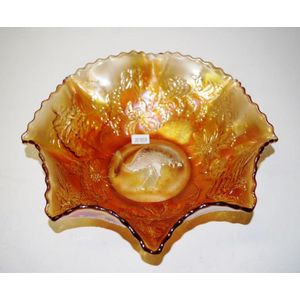Carnival Glass is pressed glass that has been iridised. The glass is firstly pressed into a mould while molten, and being in liquid form, takes on the shape of the mould. After it has been removed from the mould, it is sprayed with a coating of liquid metallic salts. This gives the surface an iridescent lustre, similar to the effect of oil floating water.
Although the technique was known in Roman times, it was not until 1907 that it was revived by Louis Comfort Tiffany. Other manufacturers taking note of their success followed suit and were able to produce a cheaper product by spraying the mixture on the glass, instead of including it in the glass mixture as Tiffany was doing.
Carnival glass was at its peak of popularity from about 1908 to the 1920's and as its popularity declined manufacturers, were left large stocks they were unable to
more...
sell. Popular legend has it that it was sold cheaply to travelling showman for prizes at carnivals, from whence came the name by which it is known today, carnival glass.
Prior to this, it went under a variety of names, including Iridill, Imperial Jewels, Imperial Art Glass, taffeta, lustre glass, Aurora and rhodium.
The Fenton Art Glass Co, is credited with being the first producer of carnival glass. Other major United States producers were Northwood Glass Company, Imperial Glass Company and Millersburg Glass Company.
Carnival glass was also produced in England, Europe, Central and South America, India, China and Australia.
In Australia, carnival glass was manufactured by the Australian Crystal Glass Company Ltd., which also traded as Crystal Glass Ltd. This company amalgamated with Australian Glass Manufacturing Co. Ltd. (later renamed Australian Consolidated Industries Ltd. and then A.C.I International Ltd.)) which eventually had a monopoly on glass production in Australia.
As in the United States, most of the carnival glass produced by Crystal Glass Company Limited was in the mid to late 1920s.
Australian themes featured strongly in their product line, with designs including the kingfisher, kangaroo, swan, emu, kookaburra, magpie, and waratah.
The range of shapes was similar to that of other carnival glass manufacturers and included various shaped bowls, salvers, jugs and tumblers, vases, float bowls and smaller items such as sugar bowls and butter dishes.
Most items made by Crystal Glass Company were in the 'marigold' colour, which showed an orange iridescence over the clear glass. This was also the most widely produced colour in the United States, the reason given being that it would brighten the dull interiors of the time. The other colour used was 'dark' which varied from light amethyst through to black, with a silvery iridescence. In other countries there was a virtual palette of colours produced.
less...






 Loading more...
Loading more...